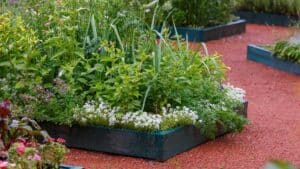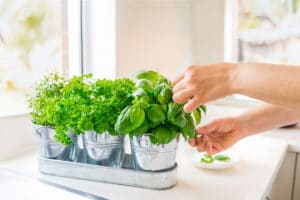Even if they can live well in the same pot for months or even years, there comes a time when plants need a new home and a new environment. Repotting allows the roots of plants that, over time, have taken up all the space available in the pot, to have more room to grow. It also allows you to provide the plants with new potting soil, in greater quantity, since the latter has not only been depleted, but has also been reduced with the growth of the plant. You will see your plants regain their vigour after being placed in a new pot of their size.
When to repot?
Depending on the variety of plants you have, you may need to repot more or less often. Some plants like peace lilies and spider plants like to change pots every year or two, while ZZ plants and aloe can stay in the same pot for many years. Be sure to ask your garden centre consultant about the plant’s needs.
Several signs may indicate that the plant is cramped and that it is time to repot it:
- Growth is slower than usual
- Leaves are turning yellow and falling off
- Roots are poking out of drainage holes or are visible above the soil
- The plant seems to always be thirsty, even when watering it
If your plant shows any of these signs, visit your favorite garden centre to choose a new pot and pick up a bag of specialized potting soil for houseplants.
Ideally, plants are repotted in the spring, when they are starting to grow again after the winter. It can be done at other times of the year if the plant requires it. However, avoid repotting plants that are in full bloom.
How to repot plants?
First of all, you need to choose a pot that is slightly larger than the one the plant is currently in. You should not go beyond 3 to 5 cm more since the plant will only concentrate on its roots at the expense of the foliage. Make sure your pot has drainage holes so that excess water can easily drain away. You don’t want the roots of the plants to be soaked in water, as this can cause them to rot.
Fill your new pot one-third full with slightly moist houseplant potting soil. Then carefully remove your plant from its container by the main stem. Separate the roots and cut off any spiral roots while removing excess potting soil.
Place your plant upright in the center of the new pot and add potting soil around the roots to hold it in place. Press lightly without pressing too much, leaving about 2 cm of free space between the potting soil and the edge of the pot: this will facilitate watering. Water to moisten all the soil. For the next few weeks, watch your plant before watering it. Its needs in water will decrease since the soil will retain more water that you will give it. Wait at least 4 weeks after repotting before feeding your plants and always follow the instructions on the label.
Don’t want to or can’t repot the plant?
If your plant is already in a large pot and it is not possible to repot it, you can scrape off the top few inches of potting soil and replace it with new soil. This is called resurfacing. This will give your plants a good boost, without changing their pot.
Need help with your indoor plants? The Centre de Jardin Floréal de Laval offers potting and repotting services. Make an appointment: https://centredejardinfloreal.com/en/services/plant-potting/






